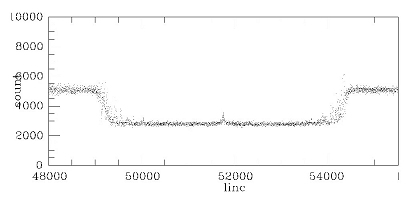Titan Occultation Observing Campaign
Introduction
Looking for Titan's Central Flash
Periodically the largest moon of Saturn, Titan, occults a bright star in such a way that the centrality of the occultation will be visible from some places on the Earth. When this occurs it is possible to observe an effect known as the central flash. Titan possesses an atmosphere and this acts like a lens focusing the starlight from the occulted star in a manner analogous to gravitational microlensing.
This flash is detected by making photometric measurements and producing a light curve. As Titan passes in front of the star the total amount of light seen from the two objects falls. At the midpoint of the occultation a small peak is observed in the light curve as the refracted starlight is detected.
This flash is a very unique way to measure accurately (to within a couple of km) the shape of Titan's atmospheric isobar near 0.25 mbar, hence giving a very tight constraint on the zonal wind system of the satellite.
Over recent years a number of observations have been made of such an event. On 14 November 2003 two such events occured within 7 hours of each other when Titan occulted the stars TYC 1343-1615-1 and TYC 1343-1865-1. Teams of observers at various locations around the world witnessed the event.
South Africa campaign
13 November 2003
The Sun is shining at SAAO Sutherland in South Africa and we are getting ready for the observation of Titan's occultation. The occultation by Titan of the star TYC 1343-1615-1 will take place at ~ 0:14 UC Nov 14 (~7 h later Titan will occult another star TYC 1343-1865-1, which will be seen from the US and Canary Islands).
I arrived in Cape Town at the South African Astronomical Observatory (SAAO) on Nov 7 together with the French 'delegation' from the observatory of Paris Meudon. At SAAO we met the South African astronomers involved in the observations.
On Nov 10 I went up to the observatory in Sutherland with Ian Glass, SAAO Senior Astronomer, while the others prepared the mobile telescopes to move to different locations on the SA west coast area.
Here at SAAO Sutherland the occultation will be observed from the 1m telescope with the UCT photometer (I band) and by the Japanese IRSF (InfraRed Survey Facility) (1.4 m Cassegrain telescope).
Last night, Ian & I undertook a practice observation session to get familiar with the telescope and instrument. We checked the performance by observing bright stars and equatorial standards while waiting for our star to rise (~02:00 local time). In the meantime Baba, a Japanese student on duty at IRSF, tested the modified SIRIUS SW for the Titan'occultation observation. Unfortunately the SW still shows random readout problems - probably due to a bug.
Tonight all the observers (in Sutherland, South Africa, Namibia and La Reunion island) will observe the two Tycho stars (the second one is used as reference) and Titan for photometric calibration, in preparation for the occultation.
The sky is clear and the weather forecast are good.
Stay tuned!
Keeping crossed fingers
Francesca Ferri
Planetary and Space Sciences Research Institute,
The Open University, UK
First Results
14 November 2003
Here at SAAO Sutherland (South Africa) we have succeeded in observing the occultation of the star TYC 1343-1615-1 by Titan around 00:10 UT (02:00 local time) on 14 November. The event has been recorded by the SAAO 1 metre telescope with a fast photometer and by the Japanese InfraRed Survey Facility (IRSF).
We are very pleased to report that the SAAO was in the centrality of the event and at ~ 00:15 UT (02:15 local time) we observed the central flash. Ian Glass and Franceca Ferri, using the 1 metre telescope, were able to capture this light curve clearly showing the central flash.
 |
|
Observed light curve of the occultation |
We were somewhat fortunate to view the event as the clouds rolled in soon after the observation was made. A few hours before the occultation we lost contact with other observers spread out along the western coast of South Africa with mobile stations - but it is very probable that they were also able to make good observations.
Francesca Ferri
Planetary and Space Sciences Research Institute,
The Open University, UK
